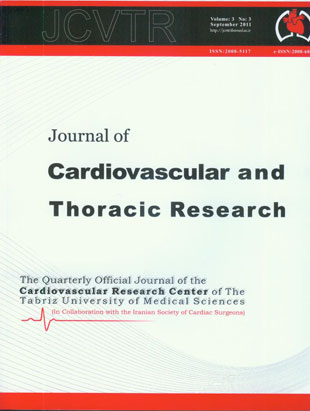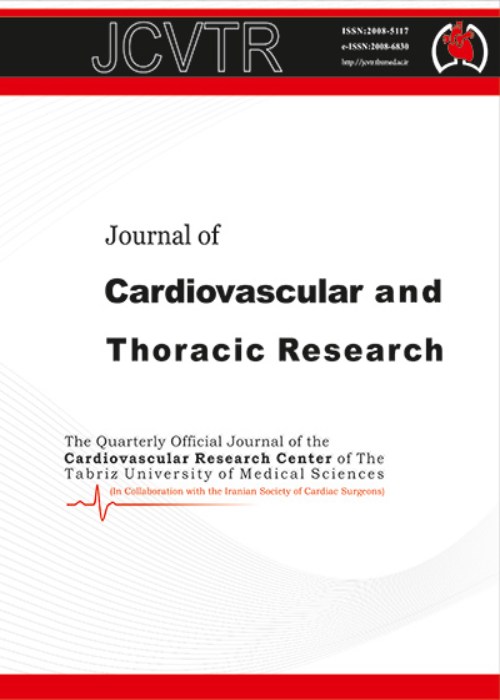فهرست مطالب

Journal of Cardiovascular and Thoracic Research
Volume:3 Issue: 3, Aug 2011
- تاریخ انتشار: 1391/01/21
- تعداد عناوین: 7
-
-
Page 73IntroductionThe atherosclerotic effect of hypercholesterolemia on the vascular function is well-known. However, limited studies were done on the effect of hypercholesterolemia without atherosclerotic lesion on the vascular compliance. The aim of this study was to investigate the effects of hyperlipidemia induced by cholesterol rich diet on vessel function in isolated rat aorta in the absence of atherosclerotic lesion.MethodsMale wistar rats were randomly divided into 3 groups of 6 animals in each. The rats in normal control group were fed a standard laboratory diet and two other groups were fed a high fat diet for 36 days. A group of high fat fed rats was treated orally with Lovastatin started at day of 16 and continued for last 20 days of the experimental period. At the end of the experiment, inferior vena cava blood was collected to measure the lipid levels and the thoracic aorta was excised and used for isolated vessel preparation and histological study.ResultsThe results of this study indicated that high-cholesterol diet significantly increased total choles-terol and LDL levels in serum (p<0.001). The increase in the serum levels of cholesterol was associated with a profound reduction of endothelium dependent vasodilatation of the thoracic aorta. However, in histopathological study no atherosclerotic lesion was observed. Short-term treatment by Lovastatin (10 mg/kg/day) produced a significant reduction (p<0.05) in the level of total cholesterol and LDL. The endothelium-dependent vasodilata-tion was improved significantly (P<0.01) by Lovastatin as an anti-hyperlipidemic drug.ConclusionHypercholesterolemia is associated with endothelial dysfunction in aorta, despite the absence of atherosclerotic lesions.
-
Page 79IntroductionBeing a unique diagnostic technique, transesophageal echocardiography (TEE) has influenced many different aspects of cardiac surgery including valve repair sur-gery. The cost-effectiveness of this method however is questioned considering the condi-tions of every region and country. In this study we aimed at answering the question if util-izing TEE throughout valve repair surgery could be cost-effective.MethodsTwenty four patients were studied within two groups of case "valve repair operation plus intra-operative TEE (IO-TEE)" and control "valve replacement operation". Variables including age, gen-der, left ventricle ejection fraction (LVEF), re-operation, intensive care unit (ICU) stay, hospital stay and cost were studied and compared.ResultsThere was no significant dif-ference regarding age, gender and LVEF between two groups (p=0.559, p=0.413, and p=0.408, respectively). ICU stay in repair group was less than replacement group (p=0.009). Hospital stay difference however was not statistically significant (p=0.928). The cost of valve repair under IO-TEE monitoring was significantly less than valve re-placement (p=0.001).ConclusionsIO-TEE not only would assist surgeons by increasing their interest toward valve repair operation instead of replacing impaired cardiac valves but also consequently decrease hospital costs. It is also advised for the cardiac anesthesiolo-gists to use IO-TEE routinely in the valve repair operations provided that there are no con-traindications.
-
Page 83IntroductionCongenital nephrotic syndrome is a severe debilitating problem associated with extra renal manifestation such as diverse cardiac findings.MethodsDuring four years 6 cases diagnosed as congenital nephritic syndrome in base of definitive criteria their documents reviewed and echocardiographic evaluation has been done for all with or with-out cardiac sign or symptoms, results gathered and expressed as incidence.ResultsAll cases have some grades of structural or functional defects from simple form like as tricus-pid regurgitation to complex defects. It may be run in consecutively in siblings of a family from non consanguine parents.ConclusionPulmonary stenosis may occur in all parts subvalvualr, valvular and peripheral parts of pulmonary artery, left ventricular hypertrophy and mitral regurgitation observed in some, moderate tricuspid regurgitation observed in half of cases due to pulmonary hypertension or right ventricular hypertrophy due to pul-monary stenosis.
-
Page 87IntroductionChest wall blunt trauma causes multiple rib fractures and will often be associated with significant pain and may compromise ventilator mechanics. Analgesia has great roll in rib fracture therapies, opioid are useful, but when used as sole agent may re-quire such high dose that they produce respiratory depression, especially in eld-erly. the best analgesia for a severe chest wall injury is a continuous epidural infusion of local anesthetic. This provides complete analgesia allowing inspiration and coughing without of the risk of respiratory depression.Methodssixty adult patients who with multiple rib fractures were enrolled in this study. They were divided into Group A or thoracic epidural with bupivacaine 0.125 % +1mg/5ml morphine and group B or inter-costal block with %0.25 bupivacaine. The patients were assessed through ICU and hos-pital stay length, ventilation function tests. Pain score among the patients was meas-ured with verbal rating scale, before and after administration of the analgesia.ResultsWe found a significant improvement in ventilatory function tests during the 1st, 2nd, and 3rd days after epidural analgesia compared with the intercostal block (P < 0.004). Changes in the visual Analogue Scale were associated with marked improvement re-garding pain at rest and pain caused by coughing and deep breathing in group A com-pared group B... ICU and hospital stay markedly reduced in Group A.Conclusiontho-racic epidural analgesia is superior to intercostals block regarding pain relief of rib frac-tures. Patients who received epidural analgesia had significantly lower pain scores at all studied times.
-
Page 93IntroductionEsophageal carcinoma is the scourge of human beings. Pulmonary compli-cations in patients who have undergone operation are common (20-30% of cases) and there are no suitable tools and ways to predict these complications.MethodsDuring a period of 10 years, from March 1998 to February 2007, 200 patients (150 male and 50 female) un-derwent Esophagectomy due to esophageal carcinoma in thoracic surgery ward retrospec-tively. Complications include the length of hospitalization, mechanical ventilation, mor-bidity and mortality. Patients’ risk factors include age, preoperative chemo-radiotherapy, stage of the disease and preoperative spirometry condition.ResultsWe grouped our pa-tients into three categories: Normal (FEV1 ≥ 80% predicted), mildly impaired (FEV1 65% to 79% predicted), more severely impaired (FEV1 < 65% predicted).Although almost all patients had radiographic pulmonary abnormalities, significant pulmonary complications occurred in 40 patients (20%) which underwent Esophagectomy. Pleural effusion and atelectasia in 160 patients (80%). 24 patients needed chest-tube insertion. 20 patients (10%) developed ARDS. 14 patients (7%) developed chylothorax. 20 patients (10%) of patients died during their postoperative hospital stay. 30 patients (15%) required mechani-cal ventilation for greater than 48 hours.ConclusionWe reviewed a number of preopera-tive clinical variables to determine whether they contributed to postoperative pulmonary complications as well as other outcomes. In general, age, impaired pulmonary function especially in those patients with FEV1 less than 65% predicted was associated with pro-longed hospital length of stay (LOS). In fact pulmonary complications rate after Esophagectomy are high and there was associated mortality and morbidity.
-
Page 97IntroductionHaemodialysis needs a credible and recurrent access to the systemic circu-lation which can be accomplished by way of central vein catheterization. We report the case of bleeding after withdrawal of the double lumen catheter.Case PresentationA 36-year-old woman who was a known case of end-stage renal disease referred to a dialysis center because of her arteriovenous fistula malfunction. A double-lumen catheter was in-serted via the right internal jugular vein but failed to become functional so in the emer-gency department we decided to withdrawal catheter under cardiac monitoring and pulse oximetry but unfortunately A few minutes after the withdrawal of the double lumen Cathe-ter the patient became agitated and confused. The resuscitation team after infusing IV fluid and blood decided to emergent thoracotomy. We control bleeding by direct pressure and repaired a rupture of the posterior aspect of the right internal jugular and right subclavian vein junction. Six hours later she became alert and one week after discharged, she was in well general condition.
-
Page 101A 44 years old male patient with acute coronary syndrome and polycystic kidney disease is described. Coronary angiography showed ectatic coronary arteries. Polycystic kidney disease is the most common inherited kidney disorder which is commonly associated with extra renal manifestations including cardiovascular conditions. Involvement of vessels may lead to arterial aneurysms which most commonly present as intracranial aneurysms. The rare association between coronary aneurysms and polycystic kidney disease has also been noted.


